Most dog owners already have their own arsenal of dog leashes. But if you don’t have a long line already, we’d really suggest adding one to your collection!
Long lines are designed to mimic the sensation of off-leash fun for dogs, while still providing some extra safety.
Below, we’ll share some of the benefits of long dog leashes below, explain the best way to use one with your pupper, and share some of our favorite long leash options.
A standard dog leash in 6ft long, so technically anything that’s longer could be considered a long leash. But the term “long leash”, or “long line” as it’s more commonly named, refers to any leash that’s 10 ft or more.
We looked for long lines with several different lengths available to suit different needs.
Lightweight materials are best for long lines, so we tested how heavy the lines were, as well as how easily the leashes navigated around brush and rocks.
We also took into account pricing and value. Long lines aren’t something most owners are going to be using on a daily basis, so we don’t want to break your wallet over these. But if you have cash to burn, there are some premium options that offer advantages.
Best Long Dog Leads (& What They’re Best For)
Not all long dog leashes are crafted with the same intended purpose. Next we’ll detail which type of long leash is best for you and your buddy, depending on your goals.
1. Hi Kiss Leash
About: If you’re just looking to give your dog a bit of extra freedom on walks, an option like this Hi Kiss Leash in a 15- or 20-foot length will certainly do the trick. Anything longer and your walk can get more cumbersome than necessary, given all the extra line slack you’ll have to lug around.
Hi Kiss has plenty of others lengths too — all the way up to a 100ft long line! They come in a slew of bright color options. And if you’re looking to save money, these are definitely the most affordable option out there for long leads.
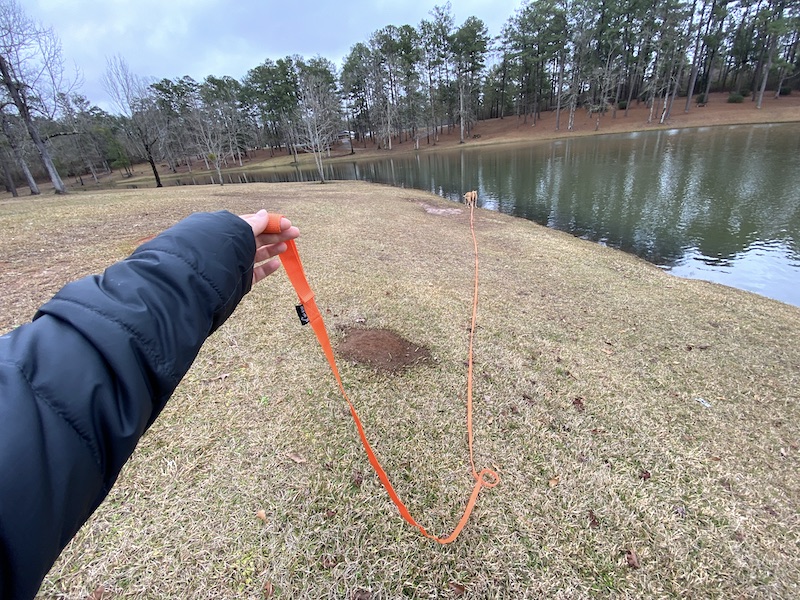
Features:
- ¾-inch-wide, lightweight leash
- Durable nylon design
- Embedded swivel-style bolt helps prevent twisting
- Tons of bright color options
Pros
- Very affordable (they’re not much more expensive than standard leashes)
Cons
- Very basic design without any bells or whistles
Long lines are most commonly used at 10ft or 20ft, but they come in 30ft, 50ft, and even 100ft too!
2. Viper BioThane Long Lead
About: If you’re looking for a long lead that can withstand a variety of weather conditions, the Viper BioThane Lead is a great choice (BioThane leashes are essentially made from nylon webbing cores and then coated with PVC outer layers).
This long lead is made in the USA and comes in sizes ranging from 15- to 33-feet, making it well suited for training sessions, or giving your pup more slack while on walkabout.
Because it has a waterproof coating, this leash can be used in water or throughout any season. It’s also built with solid brass hardware so it shouldn’t rust over time.
Finally, you can simply wipe off this leash when it gets dirty since it isn’t absorbent. This makes it one of the cleanest long lead options available (which is important to consider, as some leashes will get pretty grody after dragging on the ground all day).
When Remy and I sampled this long line, I was surprised at just how lightweight it was! It was so light and moved so smoothly across all kinds of terrain, from grass to dirt.
I also thought the long line would be harder to step on due to the material being so smooth, but there’s actually some subtle texture on the leash that allows it to catch really easily when you step on it. The bright neon yellow color was easy to keep track of too. Definitely a new favorite of mine!
Features:
- Waterproof and non-absorbent
- Made in the USA
- Comes in bright, highly visible colors and earth tones
- Durable, long-lasting design
- Available in several sizes as well as widths (anywhere from 1/2″, 3/4″, 3/8″, 5/8″)
Pros
- Great for a variety of outdoor activities
- Easier to clean than other long leads
- Perfect for scent-work as they won’t absorb odors
Cons
- May be heavier than other long lead options, so it might not give Fido the feeling of full freedom
- May be enticing to chew for the power chompers
3. NIMBLE Waterproof Long Line
About: Like the advantages of BioThane leashes but not the pricing? This one’s for you! This long lead is designed with the same principles as BioThane, featuring a flex poly coating for smooth water resistance.
This off-brand long line offers all those same benefits, but without the BioThane label (remember, BioThane® is the brand name of all coated webbing products made by BioThane Coated Webbing Corp).
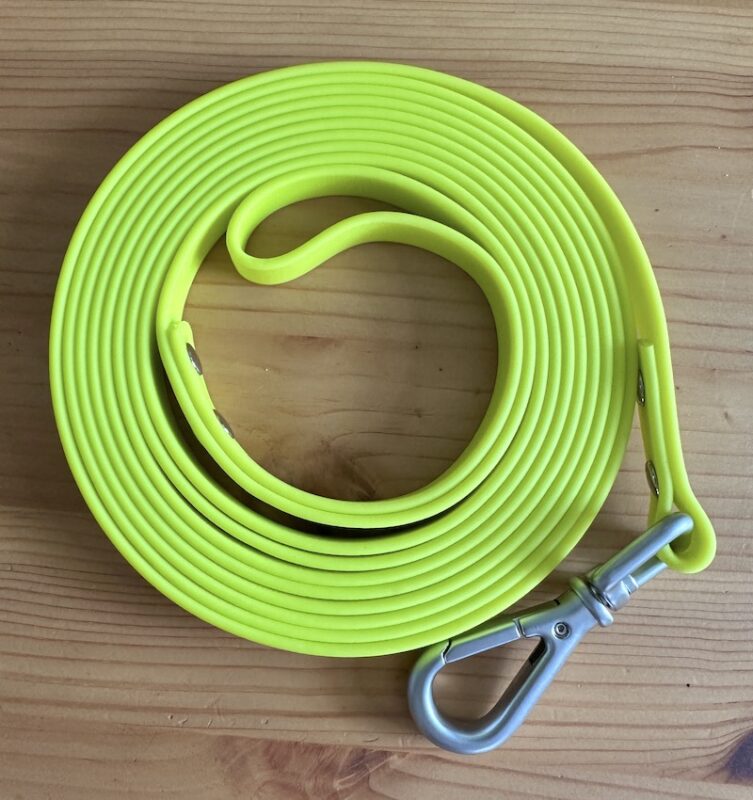
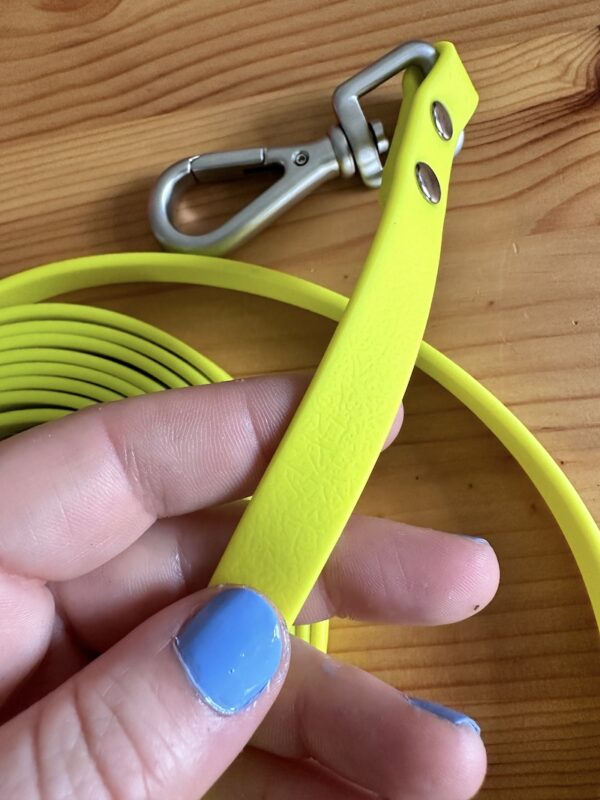
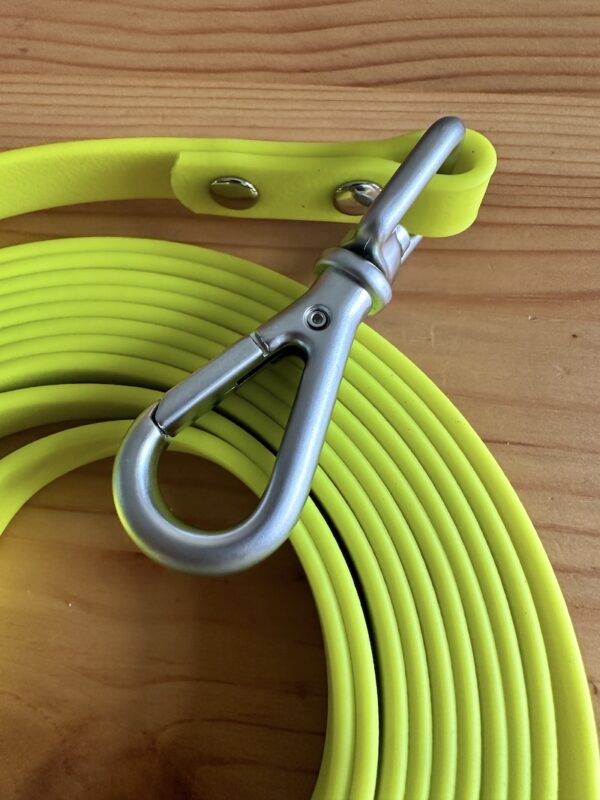
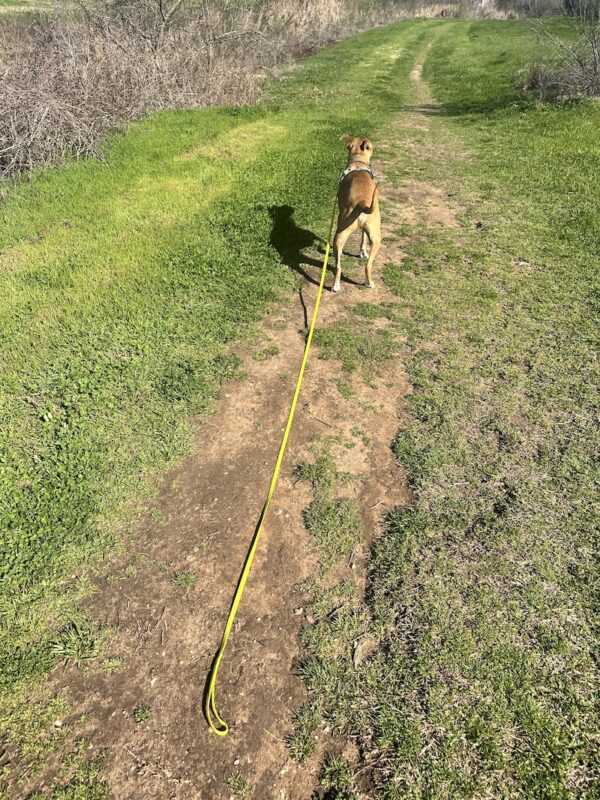
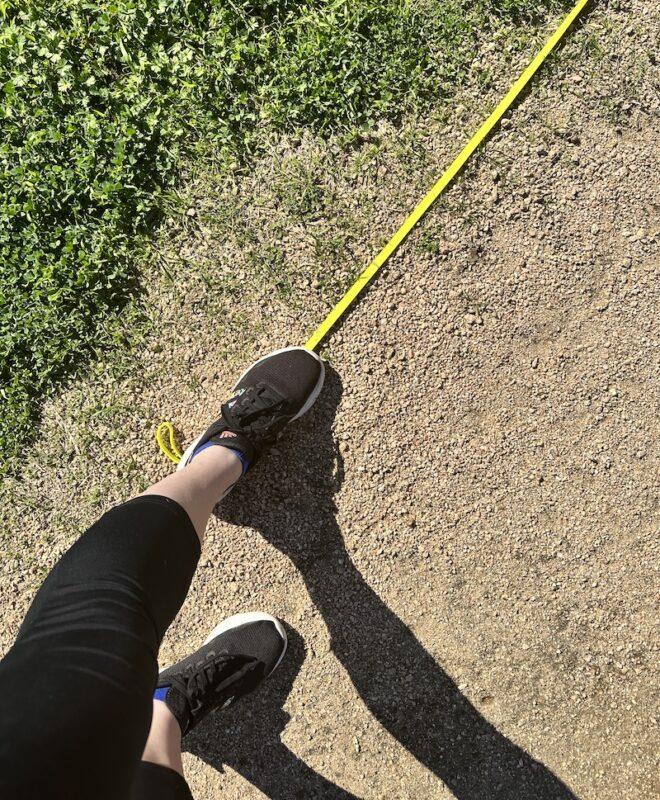
Features:
- Features nylon webbing with flex poly coating
- Easier to clean and less likely to snag that standard nylon long lines
- Comes in several bright color options
Pros
- More affordable than brand name BioThane
Cons
- Chewers can make quick work of these types of long lines
4. Loutep Long Line
About: The Loutep Long Line is pretty similar to the Hi Kiss model, featuring a basic, budget-friendly long line made of nylon.
However, it does have one difference — it boasts a padded neoprene handle (which is a bit comfier than the plain old nylon).
It too offers a swivel clasp and comes in several lengths and color options.
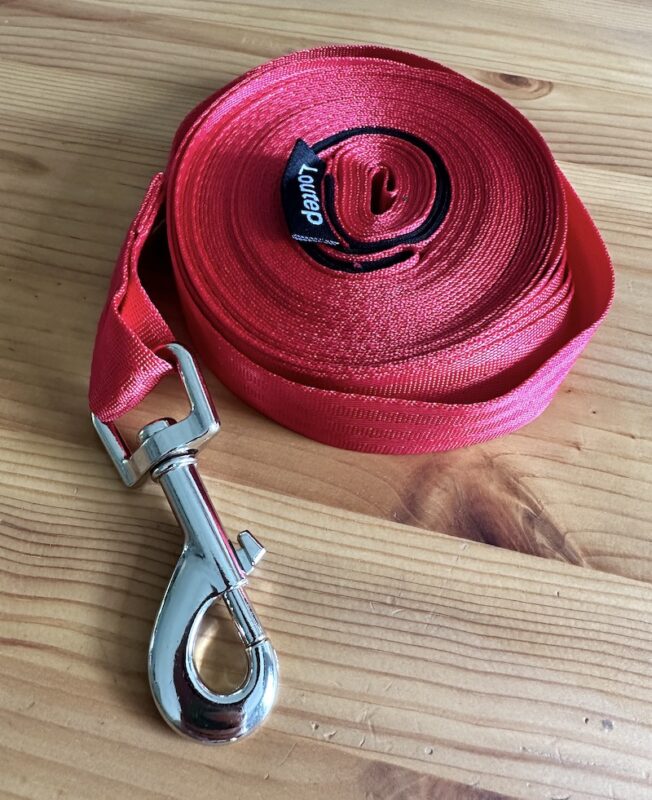
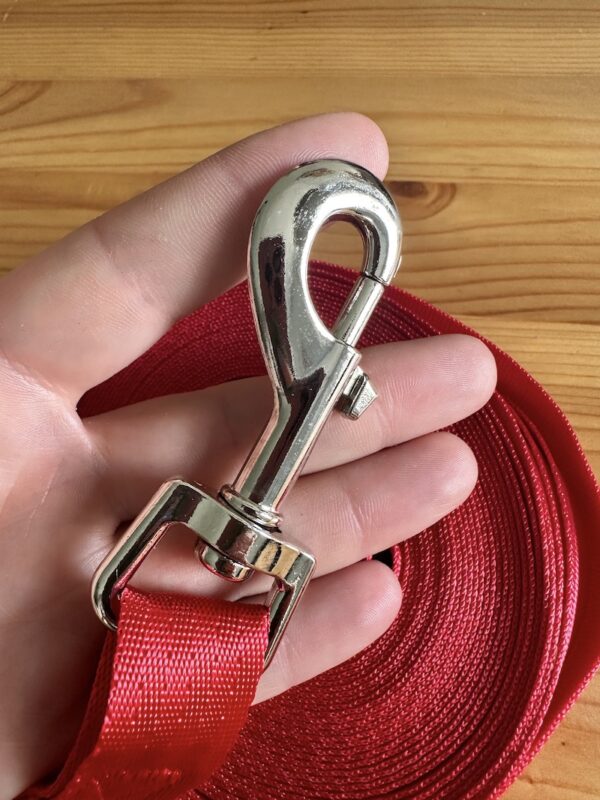
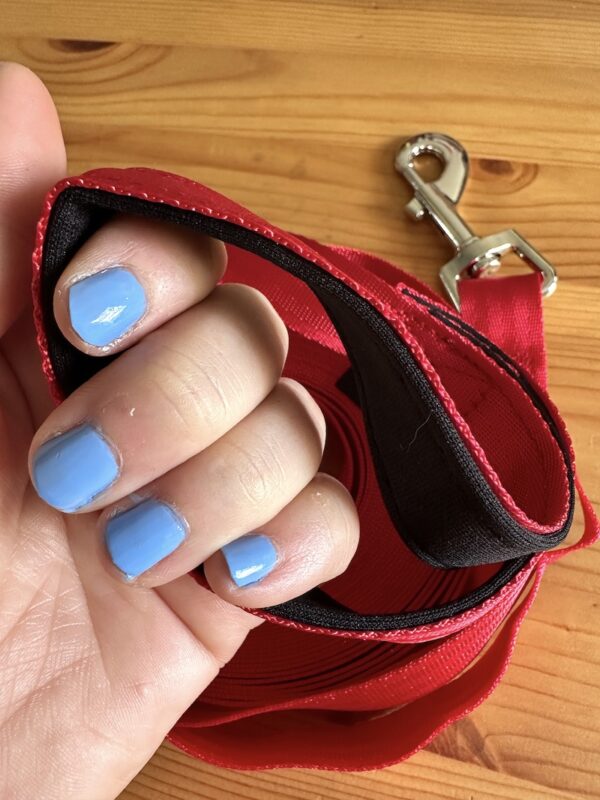
Features:
- Bright-colored options make these leashes easy to keep track of
- Can be easily tied and untied
- Made of basic nylon materials
- Includes neoprene handle
Pros
- Flexible and effective for use in several different scenarios
- Neoprene handle is a nice addition
Cons
- Nylon won’t move as smoothly around rocks and twigs for outdoor use
5. Lynxking Long Lead
About: The lynxking Check Cord Dog Lead is a little bit different than the other leashes discussed here, as it’s built a bit differently: It’s made of a heavy rope-like material instead of the nylon webbing used in most other long leads.
The big benefit of this type of long leash is that it’s easier to step on with your foot because the leash features a round (rather than flat) shape, making it easier for your shoe-covered foot to “grab.”
This isn’t to say you can’t step on a flat long leash — you can, but some might find this material a bit easier to stop securely. However, some trainers use this style of long leash when socializing questionable dogs, as they may need to stop the four-footer and reel him back in quickly.
Just keep in mind that since this leash is slightly heavier, it may not give your dog that same sensation of off-leash adventuring that a lighter-weight leash will.
Features:
- Thicker lead may be easier to handle and control quickly
- This lead comes in 15-, 30-, and 50-foot models
- This leash can be used in water
- Woven, loop-style handle provides comfort for the handler
Pros
- Durable design that’s easy to step on and control
- Lead doesn’t absorb water, so it can be used while your dog is swimming
- Swivel hooks help prevent tangling
Cons
- This won’t give your dog the same “off-leash” feel that some other leashes provide
- It’s a bit heavier than nylon leashes of the same length
What to Consider When Long Line Shopping
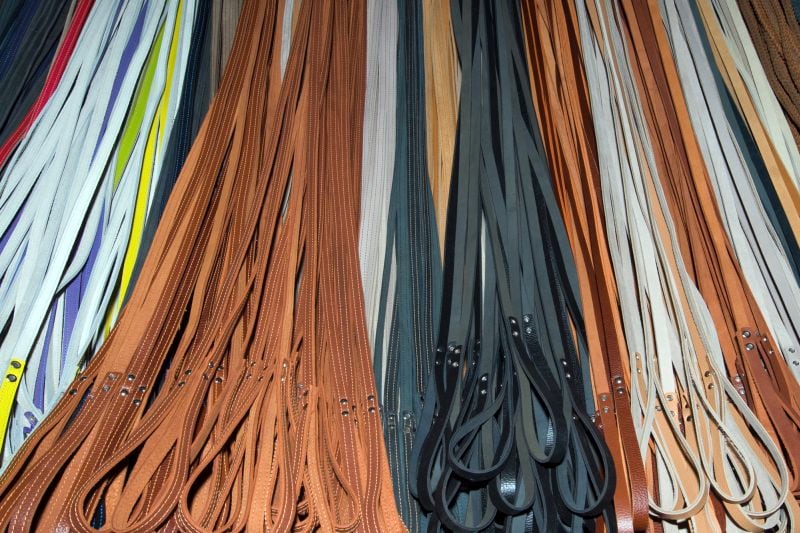
- Weight (the lighter, the better). Most good long leashes are ultralight. It’d be a hassle to have your 30ft long line be completely padded and double-layered. Plus since the goal is to mimmic off-leash freedom for your dog, you don’t want extra weight dragging them down and ruining the experience.
- Length. Obviously the best length for your long leash will depend on what you plan on doing with it. For walks around the woods, a 10 or 20 ft line is probably best. If you’re doing recall training in a large open field or remote area, a 50ft line might be better.
- Biothane vs nylon. Biothane long lines have a lot going for them — they’re smoother and less likely to get snagged on branches and rocks. But, they can also be a bit weightier and significantly more expensive than their cheaper nylon counterparts.
What Are Long Leashes Used For?
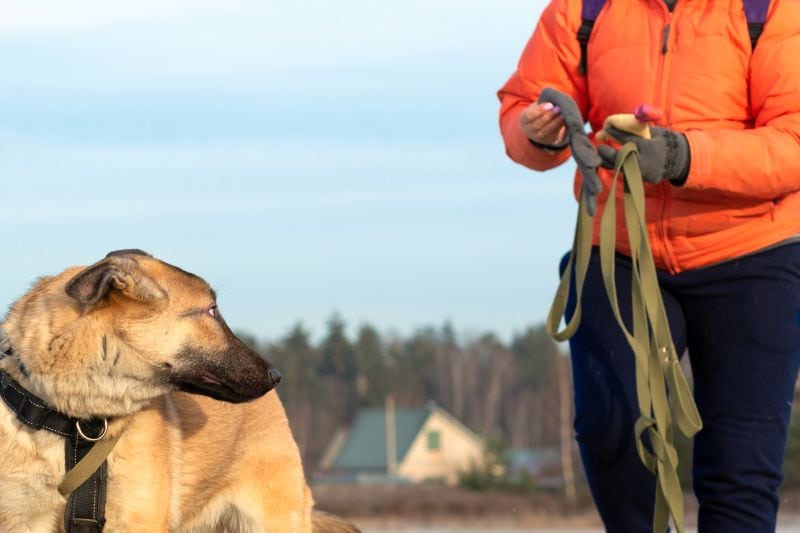
There are plenty of ways to incorporate long leashes into your dog’s routine, and they provide value in myriad ways.
A few of the things long leashes are most commonly used for include:
- “Sniffari” Walks: Long leads can give your dog the opportunity to go on more extensive sniffing expeditions, or “sniffaris” as we like to call them. Sniffing around isn’t just fun for your dog, it’s also incredibly enriching. Using a long leash, you can let your dog sniff to his heart’s content while still keeping him safe from a distance.
- Training Practice In Public Areas: One of the best ways to test your dog’s skills is to run through his tricks in public areas, like nearby parks. Long leashes give you security while training in a large open area, and they are particularly useful for commands like “stay.”
- Recall Area: One of the most important skills to build with your dog is teaching your dog to come when called — known in training lingo as “recall.” Long leashes are great for recall work, as you can let your dog wander and sniff until the end of the line, and then call your dog back to your side. If he doesn’t come when called, you can gently pull on the leash to guide him back to you!
- Puppy Training: As you’re expanding your puppy’s range around the house, it may be helpful to have a 10-foot leash trailing behind him. This way, you can gently step on the leash if your pooch is interacting with something he shouldn’t or if he gets into other kinds of puppy hijinks.
- Off-Leash Training: Long leashes allow you to safely practice your dog’s off-leash manners before fully committing to the real thing. If a dog won’t reliably listen to you on a long leash, he definitely isn’t ready for off-leash walks (keep in mind that you should still use extreme caution letting your dog off-leash unless you are in a secured, pooch approved area — even if he “proves himself” on a long lead). Also, read up on the leash laws of your area to make sure you stay in compliance with the law.
- Reactive Dog Training: Long leads can be helpful when working with reactive dogs, as the longer lead enables them to feel freer than they would on a short line. This is because your four-footer might experience heightened aggression, fear, and frustration if he feels “trapped” on a short lead. Many owners find that their dog’s reactivity is much worse when using a short leash, though these dogs can’t be allowed to roam completely off-leash for safety reasons. Long lines make excellent substitutes, as they let your dog feel less restricted when faced with a trigger. When in doubt, consult with your dog trainer to make sure it’s a good fit for your dog.
- BAT Work (Behavior Adjustment Training): BAT Training is a practice that aims to reward a dog’s calm behavior with increased freedom. This positive reinforcement technique can help your canine cooperate better while loose leash walking and standard walks. In practice, you will hold the entire 10- to 20-foot-long leash in your hands (with no leash trailing on the ground). You will then feed out and take in the leash as your dog moves, to give him the sense of being off-leash. This means your dog gets rewarded with the opportunity to sniff and explore in exchange for his calm behavior.
Long Leash Tips & Tricks
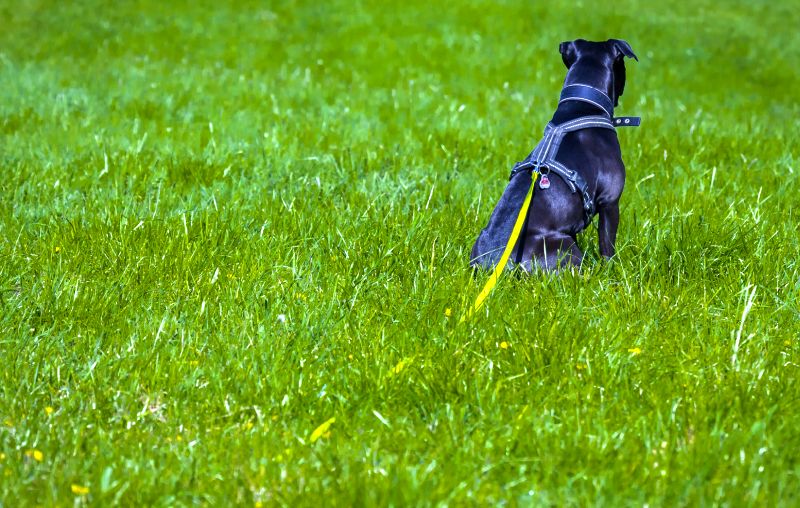
Here are a few long leash tips and tricks to ensure you have a great experience while exploring with your four-footer:
- Knot so fast! Not getting much traction when you step on your flat long line? Tie a couple of knots in the leash every 10 feet or so. This way you’ll have an easy spot to step on to stop your dog.
- Use a back clip harness. It’s important to use a back-clipped harness in conjunction with a long dog leash — not a collar! This is because your dog can do some serious damage to his throat if he is able to run full-speed and build up momentum, only to slam to a complete stop via a gigantic tug on his neck. The back clip also allows the leash to flow off the back of your pup and is therefore less likely to get tangled up in his legs compared to using a front clip (no-pull) harness.
- Avoiding applying tension to the long line. For most purposes, the goal of using a long line is to provide the sensation of off-leash freedom. In order to do this, you don’t want to put tension on the long leash. In fact, it’s best to drop the long leash, let it drag, and simply walk alongside your dog or walk near the long line dragging on the ground so that you can grab it if need be (as long as circumstances mean this is safe to do so).
- Don’t use retractable leashes. One of the key principles of long-line training is that for much of the time it is allowed to trail on the ground, not held in your hand. Retractable leashes are not suitable for this purpose and shouldn’t be used as a replacement.
- Watch out for snags. If you plan on hiking or walking in wooded areas, keep in mind that long lines can easily snag on trees, branches, and debris. If you plan on using a long line in these settings, you may want to opt for a BioThane leash, as they don’t tend to snag quite as easily. Also, BioThane leashes (like the Viper model recommended above) often come in bright colors that are easy to see amidst the forest floor.
- Things may get messy. Keep in mind that any leash left trailing behind your dog, especially in a wooded area, is bound to collect dirt or become stained. Accordingly, you’ll want to clean it regularly and store your long leash separately from your standard walking leashes.
- Introduce your dog to the long lead indoors. If you’re not sure how your dog will react to the long lead sensation, test it out indoors preemptively. Have your dog run around and step on the lead periodically to see how he reacts. Once you’re sure that you and your dog feel secure, you’re ready to put the long lead to good use outside.
***
A long dog leash is an excellent piece of dog training equipment that should be in every dog owner’s arsenal. Long leads give your dog the feeling of sweet freedom, while still keeping everyone safe and sound.
Do you have a long leash for your pooch? What’s your favorite way to use it? We’d love to hear all about it in the comments below!
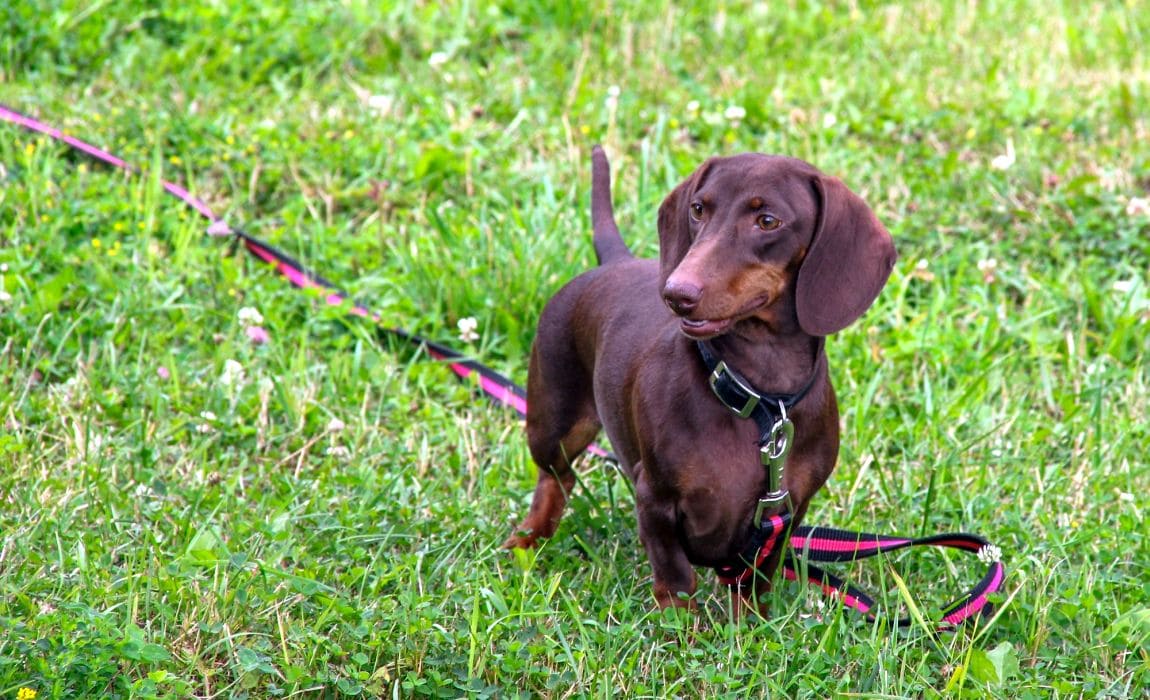




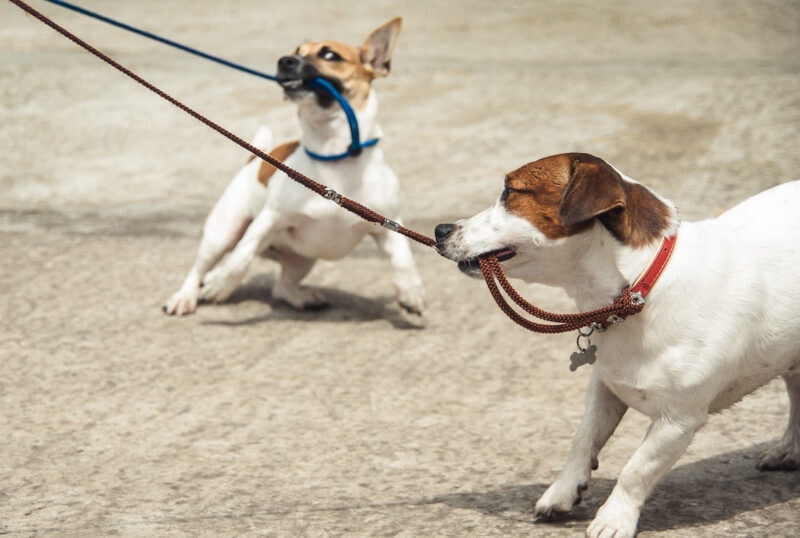

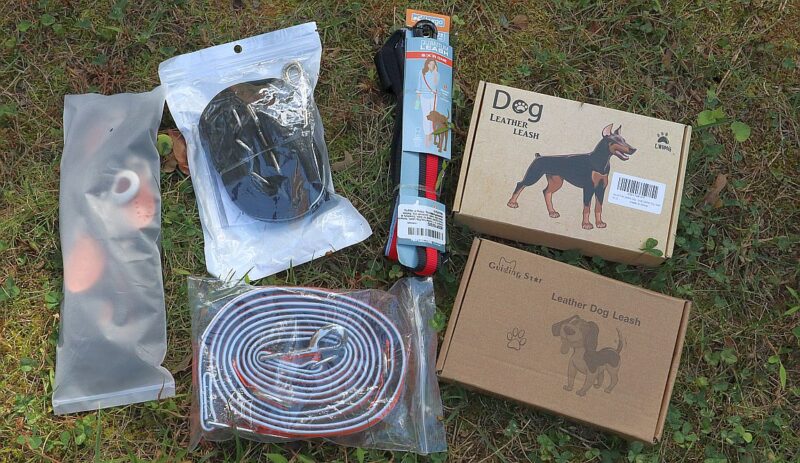
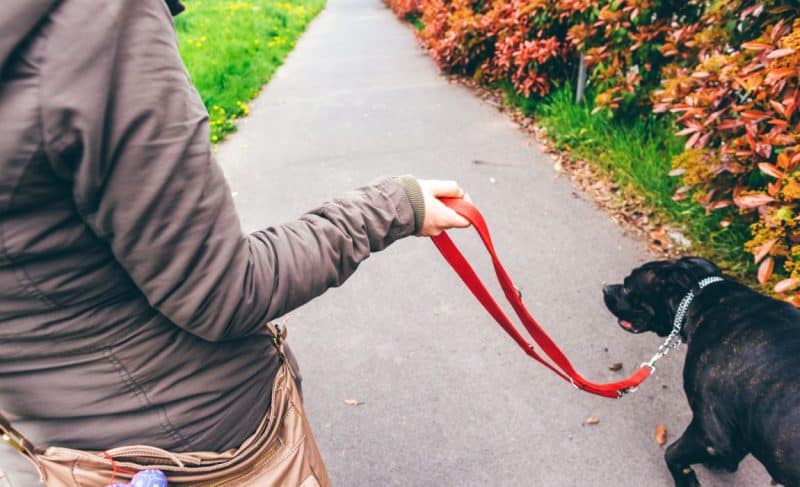
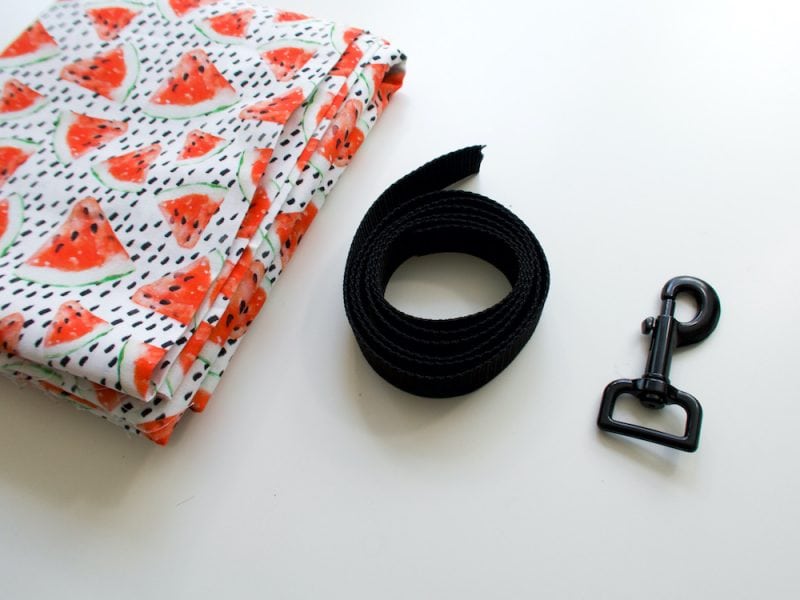
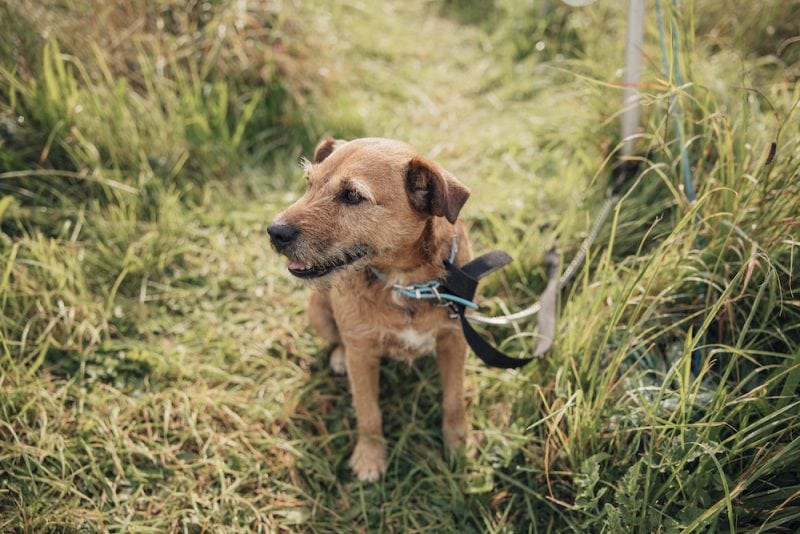

Leave a Comment